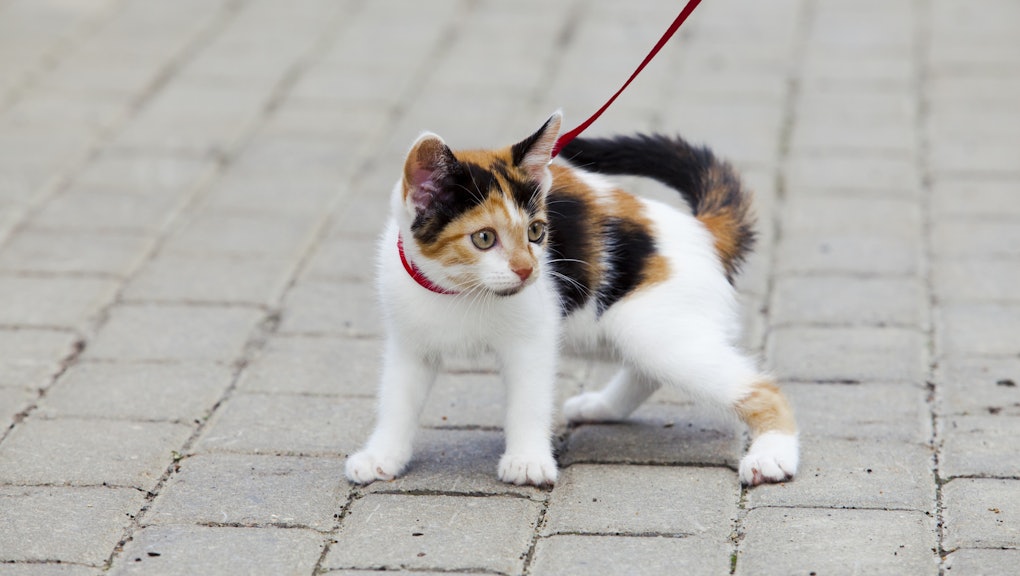When my now 10-year-old cat, Cabbage, was but a wee kitten, I tried to teach her to walk on a leash. She would slink under cars and pull and hiss and it would usually take about a half hour to get to my best friend’s home, which was just a few hundred feet from my own. I gave up on the leash, but as Cabbage got older, she started coming on walks with me and my pups with no prompting. She now just follows us out the door and down the block. All my neighbors are really impressed with the fact that I can now walk my cat — and that she seems happy on these walks — but I didn’t actually do anything to coerce her into this habit. Cabbage seemed to just decide that walking outside is cool, but a leash was not.
Walking around outside isn’t the move for all cats. But a lot of people want to walk their cats and are willing to figure out the best way to do that. So I asked some experts about cat-walking as a concept, as well as how to execute a successful stroll.
 Sari ONeal / Shutterstock
Sari ONeal / Shutterstock
–
First of all, should you consider walking your cat? Yes, says Adam Christman, a New Jersey-based veterinarian. Apparently, it’s a great way to bond with cats and make sure they are living a healthy feline lifestyle. “Walking a cat not only increases the human-animal bond to its pet parent, but also encourages cat exercise,” Christman says, but adds that it can be a difficult but worthwhile endeavor. “Exercising cats is not easy, but if a cat can enjoy walking on the leash, then it is a total win,” he says. He tells me that walking a cat stimulates them and gives meaningful purpose to their day. I always thought cats were existential by nature, but maybe they just need more exercise.
Certain cats if presented with a leash, will chew the thing right off immediately and shoot you a “don’t try that shit with me again” look before retreating to their chosen lounging-spot of the week. But especially if you live in a city, some type of leash is necessary. Christman has some good tips for getting your cat acclimated. “Believe it or not, cats tolerate leashes and harnesses very well,” he says. “If you have them as kittens, it makes them more likely to be desensitized to walking them on a leash. They should be introduced to the harness by putting a harness on indoors — the first few times they may roll around, hiss, and try to get rid of it, but eventually they will accept it. Let them become accommodated to wearing it before attaching a leash to it and going outdoors.” That’s where I might’ve gone wrong with baby Cabbage. I just just threw a harness on her and took her right outside. She was not feeling it.
 Michele Camargo Pevide / Shutterstock
Michele Camargo Pevide / Shutterstock
–
Also, I tried to walk her the way I walk my dogs. Trying to be in charge of your cat’s meandering, Christman says, is the wrong approach. “Walking a cat isn’t like walking a dog; you don’t walk a cat, the cat walks you. You follow along. You can apply gentle pressure to keep the cat going in an approximate direction, but never pull or tug. And yes, you sometimes have to pick the cat up and turn it around when it’s time to go back home.” They do need a little guidance and direction from you, he adds. This seems pretty aligned with cats’ collective independent, borderline regal vibe.
I ask Christman if he has any other cat-leash-training hacks. “I always recommend giving your cat a ‘high-value treat,’ like tuna or chicken breast, when they come back inside,” he says, “This helps your cat associate the walk and the act of returning home and back inside with food and makes it a pleasurable activity.”
Say your cat does take to outdoor walks; there are a few logistical and safety considerations to keep in mind. “Cats have a hunting instinct so make sure they are secure in their harness. If they see something, like a bird, another cat, or a dog, they may turn from your fur baby to a lion in a nanosecond,” Christman notes, “Be sure you find a suitable location to walk your cat, like a quiet park. Walking your cat for the first time in the city or busy neighborhood will seriously cause detriment to both you and your cat.”
Christman also tells me that it’s easy for external parasites (fleas, ticks and mosquitos) to jump on a cat outside. “I always recommend the topical, Revolution-Plus, a one-a-month flea/tick/heartworm and intestinal parasite preventive that protects cats from these nasty pests,” he says. “You should also be prepared if they go off leash. Make sure your cat is microchipped and that their information is accurate, and be sure your cat wears a collar with a name tag and your phone number.”
This article was originally published on









